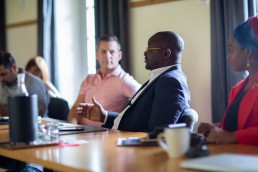The Decisions Behind Aadhaar's Success Story
CONVERSATIONS AT BELLAGIO
The Decisions Behind Aadhaar's Success Story with Tanuj Bhojwani
The decisions behind Aadhaar’s success story revolves around big and small strategies. According to Findex data from 2014, only 53 percent of adult Indians had bank accounts. By 2017, that number had jumped to 80 percent and traditionally excluded demographics shared in these gains. Women saw a 30 percent increase in account ownership, and the poorest households saw a 40 percent increase. The remarkable addition of 300 million accounts in just a few years can be largely contributed to the Pradhan Mantri Jan Dhan Yojana scheme which mandates that every household has at least one bank account and the biometric ID Aadhaar which grants residents a unique identification number that can be used to access financial services. First available in 2010, Aadhaar is now used by 1.2 billion Indians.
However, beyond increasing the number of bank accounts, Aadhaar has become an integral component of several flagship government programs including the Mahatma Gandhi National Rural Employment Guarantee Scheme (MGNREGS) and the public distribution system (PDS), two of India’s largest welfare programs. The biometric authentication helps ensure that the gains are delivered to actual beneficiaries, instead of fake or duplicates, thereby cutting food shortages. Currently, around 90 percent of all welfare recipients receive their government benefits through Aadhaar.
In this video, Tanuj Bhojwani, a representative for the iSpirit Foundation, shares his thoughts on the big and small decisions that made Aadhaar a success and why the user-experience for welfare beneficiaries has improved through the adoption of the biometric ID. Bhojwani recently participated in the “Identifying Practical Solutions to Accelerating Digital Financial Services for Inclusive Economies” conference where he shared the key lessons learned from India’s successful implementation of Aadhaar to key regulators from Indonesia, Egypt and Nigeria. To learn more about the conference click here
Estonia’s Digital Society with Kalle Palling
CONVERSATIONS AT BELLAGIO
e-Estonia: the Development of Estonia’s Digital Society with Kalle Palling
As governments around the world wrestle with challenges from technology, including data collection and cyber threats, Estonia might offer a blueprint for how to build a digital society. Taxes are completed online in under 5 minutes, 47 percent of citizens use internet voting, and 99 percent of Estonia’s public services are available on the web 24 hours a day. This digital integration of almost all of the government services is especially remarkable, considering the financial state of the country nearly 30 years ago.
Estonia was a relatively poor country when it regained independence in 1991 after the Soviet Union collapsed. To modernize the economy, it embarked on a series of fast-track reforms and adopted a digital approach from the start. Today, Estonia is home to more private companies valued at more than $1 billion, per capita than any other small country in the world.
In this video, Kalle Palle, MP of Parliament (Reform), shares his thoughts on Estonia’s digital revolution and the consistent need for government transparency and accountability when it comes to cyber security.
Palle recently participated in the “Identifying Practical Solutions to Accelerating Digital Financial Services for Inclusive Economies” conference at the Bellagio Center in Italy where he shared the key lessons learned from Estonia’s successful implementation of the digital ID to key regulators from Indonesia, Egypt and Nigeria.To find out more about the conference click here.
Increasing the pipeline of women leaders with Aishah Ahmad
CONVERSATIONS AT BELLAGIO
Increasing the pipeline of women leaders with Aishah Ahmad
According to Oliver Wyman, financial services will not reach even 30% female Executive Committee representation globally until 2048 at current rates of growth. In this short interview, Aishah Ahmad, a Deputy Governor at the Central Bank of Nigeria, discusses how financial institutions can increase the pipeline of women leaders by making sure top talent remains.
Ahmad recently participated in the “Identifying Practical Solutions to Accelerating Digital Financial Services for Inclusive Economies” conference at the Bellagio Center in Italy. To find out more about the conference click here.
Identifying Practical Solutions for Regulators
In July 2019, CCX Inclusive Business (CCX), in partnership with the Bill and Melinda Gates Foundation, convened a small number of senior financial sector policy-makers and regulators at the Rockefeller Foundation’s Bellagio Center. Participants from three of the most important markets—Egypt, Nigeria, and Indonesia—along with experts from India, China, and Estonia, joined for a working meeting entitled, “Practical Solutions to Accelerating Digital Financial Services for Inclusive Economies.”




